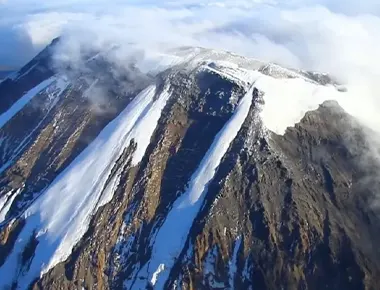Is Kilimanjaro a Volcano? | Geological Facts and History
Is Kilimanjaro a volcano? The answer is yes! Mount Kilimanjaro, though primarily known for its breathtaking treks, is also an awe-inspiring geological wonder. As the highest peak in Africa, it is a dormant stratovolcano that formed millions of years ago through volcanic activity. At Jaynevy Tours, we help climbers explore the fascinating geology of Kilimanjaro, from its lava flows to its volcanic craters. This guide provides insights into the volcano's formation, eruptions, and why it remains an iconic feature of East Africa’s landscape.
Home Mail UsIs Kilimanjaro a Volcano? | Geological Facts and History
Mount Kilimanjaro towers above the Tanzanian plains as Africa’s highest peak—and yes, it’s a dormant volcano. Its impressive summit and glacial caps rest atop a complex volcanic structure formed over millions of years. In this deep dive, we explore Kilimanjaro’s volcanic origins, its three distinct cones, eruptive history, and how geology shaped one of the world’s great trekking destinations.

Kilimanjaro’s Volcanic Nature
Kilimanjaro is a dormant stratovolcano situated near the crest of the East African Rift. Composed of alternating layers of lava flows, ash, and volcanic debris, stratovolcanoes like Kilimanjaro build steep profiles over successive eruptions. Although no historic eruptions have been recorded, fumarolic (gas venting) activity persists within Kibo’s summit crater.
Three Volcanic Cones: Shira, Mawenzi, and Kibo
- Shira (3,962 m): The oldest, now an eroded plateau on the western flank.
- Mawenzi (5,149 m): A rugged secondary cone with jagged peaks—formed after Shira but before Kibo.
- Kibo (5,895 m): The youngest and highest cone, home to the summit crater and residual glacier caps.
Geological Formation and Age
Kilimanjaro’s volcanic activity began around 2.5 million years ago. Shira emerged first, followed by Mawenzi about 1 million years ago. Kibo’s formation dates to roughly 500,000 years ago, culminating in its classic summit cone. These ages come from radiometric dating of lava flows and volcanic ash layers.
Eruptive History and Dormancy
The last major eruptive phase at Kibo occurred roughly 200,000 years ago. Since then, only minor phreatic (steam-driven) events and continuous venting of sulfurous gases have occurred. No documented eruptions exist in human history, classifying Kilimanjaro as dormant rather than extinct.
Glacial History and Climate Impact
During Pleistocene ice ages, Kilimanjaro’s glaciers extended far below today’s snow line. Warming climates have caused dramatic retreat—over 80% of ice volume lost since 1912. These glaciers carve classic cirques and feed high‑altitude ecosystems, but their disappearance threatens water supplies for downstream communities.
Current Volcanic Monitoring
Kilimanjaro National Park and the Tanzania Meteorological Agency maintain a network of seismic stations on the mountain’s flanks. Continuous gas measurements, ground deformation surveys, and occasional aerial inspections ensure early detection of any volcanic unrest—even though risk remains extremely low.
Cultural Significance & Geotourism
To local Chagga communities, Kilimanjaro’s volcanic soil symbolizes fertility and spiritual power. Today, geotourism enthusiasts trek its slopes not only for the summit but to observe lava flows, collapsed calderas, and summit fumaroles—unique geological landmarks among world peaks.
FAQs: Kilimanjaro’s Volcanic Facts
1. Is Kilimanjaro still an active volcano?
No historic eruptions have occurred; it’s classified as dormant. Summit fumaroles indicate residual heat but no magma movement.
2. Could Kilimanjaro erupt again?
While future activity cannot be ruled out geologically, current monitoring shows no signs of magma resurgence. Eruption risk is considered very low.
3. Why does Kilimanjaro have glaciers?
Glaciers formed during past ice ages where summit altitudes allowed year‑round snow accumulation. Warming has reduced them dramatically, but pockets remain in shaded crater basins.
4. How did the East African Rift shape Kilimanjaro?
The rift’s tectonic stretching created volcanic conduits. Rising magma exploited these faults to build the mountain’s cones over hundreds of thousands of years.
5. Which cone is the oldest?
Shira is the oldest, now heavily eroded into a plateau. Mawenzi and then Kibo formed later in successive volcanic phases.
Final Thoughts
Kilimanjaro stands as a majestic geological monument—an ancient stratovolcano shaped by rift dynamics, ice ages, and volcanic forces. Understanding its volcanic history enriches the trekking experience, transforming the climb into a journey through deep time. Next time you gaze across Africa’s rooftop, remember: you’re walking on layers of lava, ash, and ice that tell the story of our dynamic planet.
BOOKING FORM
Book your tour here
RELATED PACKAGES
- Baraka Aquarium and Nungwi Village in Zanzibar
- Diving Tour in Zanzibar
- Zanzibar Sky Diving Tour
- Dolphin Snorkeling Sandbank Tour in Zanzibar
- Horse Riding Tour in Zanzibar
- Jet Ski Tour in Zanzibar
- Jozani Forest Visiting in Zanzibar
- Quad Bike Tour in Zanzibar
- Traditional Sunset Dhow Cruise Tour in Zanzibar
- The Best Stone Town Tour in Zanzibar
- Zanzibar Butterfly Tour
MORE PACKAGES
- Mount Kilimanjaro
- Ngorongoro Crater
- Serengeti National Park
- Tarangire National Park
- Lake Manyara National Park
- Zanzibar Island
- East Africa Packages
- Tanzania Safari From Zanzibar
- Kenya packages
- Rwanda Packages
- Uganda packages
- Mikumi National Park
- Kitulo National park
- Mkomazi National park
- Selous (Nyerere National Park)
